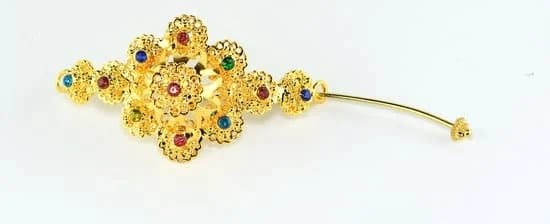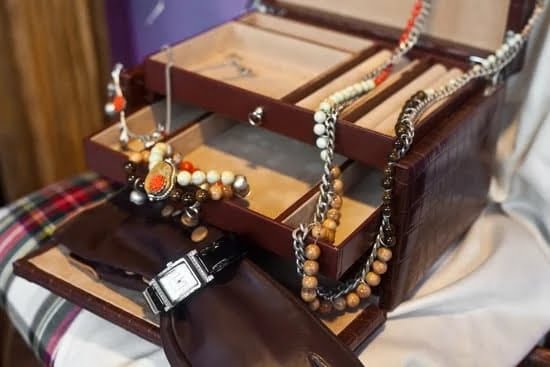Displaying fine jewelry is not just about showcasing its beauty, but also about creating an enticing visual experience for potential customers. The way you present your jewelry can significantly impact its perceived value and the success of your sales. In this article, we will explore the importance of proper display for fine jewelry and provide tips on how to effectively showcase your collection.
When it comes to displaying fine jewelry, the right materials and cases play a crucial role in enhancing the overall presentation. Additionally, lighting techniques can make a significant difference in highlighting the brilliance and sparkle of each piece. We will also discuss how organizing and categorizing your jewelry for display, as well as incorporating props and backgrounds, can add visual appeal to your showcase.
Moreover, security measures are essential when presenting valuable items like fine jewelry. We will delve into various ways to ensure the safety of your collection while still making it accessible for viewing. Finally, we will touch on virtual display options and offer tips for maintaining the display of fine jewelry. Whether you are a jeweler or simply looking to enhance your personal collection’s presentation, this article aims to provide valuable insights into effectively showcasing fine jewelry.
Importance of Proper Display for Fine Jewelry
The importance of proper display for fine jewelry cannot be understated. A well-executed display can enhance the perceived value of the jewelry, attract customers, and ultimately lead to increased sales. Whether you are a jewelry retailer or a designer showcasing your pieces at an exhibition, the way you present your fine jewelry plays a crucial role in captivating potential buyers.
One of the most critical aspects of displaying fine jewelry is choosing the right materials and cases. High-quality display materials such as velvet or suede provide an elegant backdrop for the jewelry, while glass or acrylic cases not only offer protection but also allow customers to have a clear view of the pieces. Additionally, incorporating lighting techniques that highlight the brilliance and sparkle of the jewelry is vital in creating an enticing display.
When organizing and categorizing fine jewelry for display, it is essential to consider factors such as metal type, gemstones, and design styles. Grouping similar pieces together can help customers easily find what they are looking for. Moreover, using props and backgrounds can add visual appeal to the display. For example, placing a floral arrangement or a decorative item relevant to your brand’s image can enhance the overall presentation.
Incorporating security measures is another crucial aspect when displaying fine jewelry. This includes installing security cameras, hiring security personnel, and using locked display cases to prevent theft. By creating a secure environment for your valuable merchandise, you can provide peace of mind to both yourself and your customers. Overall, knowing how to display fine jewelry effectively can significantly impact your sales and enhance your brand’s image.
| Display Material | Lighting Techniques |
|---|---|
| High-quality velvet or suede | Use focused spotlights to highlight individual pieces |
| Glass or acrylic cases | Backlighting to create a sense of depth and dimension |
Choosing the Right Display Materials and Cases
When it comes to showcasing fine jewelry, choosing the right display materials and cases is crucial in order to enhance the beauty and value of the pieces. Whether you are a jewelry store owner, a jewelry designer, or an artist participating in a trade show, selecting the appropriate display materials and cases can make a significant impact on how your fine jewelry is perceived by potential customers or clients.
Quality and Aesthetics
The first consideration when choosing display materials for fine jewelry is the quality of the materials themselves. Opt for high-quality display cases, stands, and trays that not only provide a secure environment for your pieces but also complement their aesthetic appeal. Look for materials such as velvet, suede, or leather for displaying delicate fine jewelry items, as these materials exude luxury and elegance.
Transparency and Visibility
Another important factor to consider is transparency and visibility. Transparent display cases made of glass or acrylic are ideal for allowing customers to get a clear view of the fine jewelry items without compromising their security. Additionally, consider using rotating displays or tiered stands to maximize visibility and make it easier for customers to browse through different pieces.
Showcasing Versatility
Furthermore, it’s important to choose display materials that allow you to showcase the versatility of your fine jewelry collection. Adjustable displays or modular cases can be used to create versatile arrangements that can adapt to different sizes and styles of jewelry.
This not only creates visual interest but also allows you to effectively showcase the range of your collection. Overall, selecting the right display materials and cases involves considering both the practical aspects of security and organization as well as the aesthetic appeal that will attract customers.
Lighting Techniques to Highlight Fine Jewelry
When it comes to displaying fine jewelry, lighting plays a crucial role in highlighting the brilliance and beauty of each piece. Proper lighting can make a significant difference in how customers perceive the quality and value of the jewelry on display. This section will explore the different lighting techniques that can be used to effectively showcase fine jewelry in a retail setting.
Types of Lighting
There are several types of lighting that can be used to highlight fine jewelry, including ambient lighting, accent lighting, and task lighting. Ambient lighting provides overall illumination in the display area, while accent lighting is used to draw attention to specific pieces or areas within the display. Task lighting is more focused and is often used for specific tasks such as inspecting or cleaning jewelry.
Color Temperature
The color temperature of the light is also an important consideration when displaying fine jewelry. Warm light (yellow tones) can create a cozy and inviting atmosphere but may not accurately represent the color of the jewelry. On the other hand, cool light (blue tones) can enhance the sparkle and brilliance of diamonds and gemstones but may feel less welcoming. A balance between warm and cool light is often recommended to create an inviting yet accurate representation of the jewelry.
Adjustable Lighting
To accommodate different types of jewelry and materials, it’s beneficial to have adjustable lighting options in place. This allows for flexibility in highlighting different pieces according to their specific characteristics. For example, adjustable spotlighting can be used to direct focused beams of light onto individual items, while dimmable lights offer control over brightness levels for optimal showcasing.
Overall, using effective lighting techniques is essential in creating an enticing display for fine jewelry that captures attention and showcases its true beauty. Whether it’s using different types of lighting, adjusting color temperature, or incorporating adjustable options, paying close attention to lighting details can significantly impact how customers perceive and appreciate the displayed jewelry.
Organizing and Categorizing Fine Jewelry for Display
When it comes to displaying fine jewelry, proper organization and categorization are essential to showcase the pieces effectively. One of the key aspects of this process is to ensure that each piece of jewelry stands out without overwhelming the overall display.
To achieve this, start by organizing the jewelry by type, such as rings, necklaces, bracelets, and earrings. Within each category, further categorize the pieces by style, metal type, gemstones, or any other distinguishing features. This will not only make it easier for customers to find what they are looking for but also adds a sense of order and elegance to the display.
Another important aspect of organizing and categorizing fine jewelry for display is to consider the target audience. For example, if you cater to a younger demographic, you may want to group trendy or fashion-forward pieces together. On the other hand, if your target market is more mature and traditional, grouping classic or timeless pieces would be more effective.
| Point | Details |
|---|---|
| Jewelry Organization | Group jewelry by type (rings, necklaces, bracelets, earrings) then further categorize by style or distinguishing features |
| Consider Target Audience | Organize jewelry based on the preferences and style of your target market |
Lastly, make sure that each piece is given enough space to shine on its own. Overcrowding a display with too many items can be overwhelming for customers and may diminish the appeal of individual pieces. By implementing a methodical approach to organizing and categorizing fine jewelry for display in your store or at an event, you can create an inviting and visually appealing environment that draws in potential buyers.
Incorporating Props and Backgrounds for Visual Appeal
When it comes to displaying fine jewelry, incorporating props and backgrounds can greatly enhance the visual appeal of your display. This section will provide tips and ideas on how to effectively incorporate props and backgrounds to make your fine jewelry stand out and attract customers.
Choosing the Right Props
Selecting the right props can help set the mood and highlight the beauty of your fine jewelry. Consider using items such as luxurious fabrics, elegant display stands, or thematic elements that complement the style of the jewelry. For example, if you are showcasing vintage pieces, consider using antique furniture or vintage accessories as props to create a cohesive theme.
Creating Engaging Backgrounds
The background of your display plays a crucial role in drawing attention to your fine jewelry. Opt for backgrounds that provide contrast and make the jewelry pop. Dark backgrounds can make diamonds and other light-colored gemstones shine, while neutral or textured backgrounds can add visual interest without overwhelming the jewelry itself.
Using Props and Backgrounds Thoughtfully
It’s important to use props and backgrounds thoughtfully so that they don’t overshadow the main focus, which is the fine jewelry itself. Keep props minimal and strategically placed to draw attention to specific pieces. Avoid cluttering the display with too many distracting elements that may take away from the beauty of the jewelry. Additionally, ensure that any background patterns or textures do not clash with the style of the jewelry being showcased.
By carefully selecting props and backgrounds, you can create a visually appealing display that effectively showcases your fine jewelry collection and entices customers to take a closer look at your pieces.
Security Measures for Displaying Fine Jewelry
When it comes to displaying fine jewelry, security is a top priority. Implementing the right security measures not only protects your valuable inventory but also gives customers peace of mind when browsing and purchasing your pieces. Here are some essential security measures to consider when displaying fine jewelry:
- Install high-quality surveillance cameras throughout the display area to monitor all activity and deter potential theft.
- Utilize locking display cases or safes to secure expensive pieces, especially during non-business hours.
- Consider employing security personnel or guards to keep a watchful eye on the display area and provide assistance to customers if needed.
By taking these security measures, you can create a safe and secure environment for both your jewelry and your customers.
In addition to physical security measures, it’s also important to implement digital security features. This includes using encrypted online platforms for virtual display options, requiring authentication for access to inventory databases, and regularly updating cybersecurity protocols to prevent data breaches. Protecting customer information and transactional data is just as important as securing the physical jewelry itself.
Creating a Captivating Visual Merchandising Display for Fine Jewelry
When it comes to displaying fine jewelry, the visual appeal is crucial in attracting and engaging potential customers. A captivating visual merchandising display can make all the difference in showcasing the beauty and elegance of fine jewelry pieces. Here are some key elements to consider when creating a compelling display for your fine jewelry.
- Utilize different types of display materials: Incorporating a variety of display materials such as velvet, leather, or suede can add depth and texture to your display. Use busts, stands, trays, and risers to showcase different types of fine jewelry such as rings, necklaces, bracelets, and earrings.
- Consider the use of glass display cases: Glass display cases not only provide security for your valuable fine jewelry but also offer a clear view for customers to admire each piece. Choose cases with adjustable shelves and proper lighting to enhance the visibility of the jewelry.
- Implement effective lighting techniques: Proper lighting is essential in highlighting the brilliance and sparkle of fine jewelry. Utilize spotlights, track lighting, or LED lights to create focal points on specific pieces or areas of your display.
Incorporating these elements will help you create an eye-catching visual merchandising display that will attract customers and elevate the presentation of your fine jewelry collection. By paying attention to detail and utilizing creative techniques, you can effectively showcase the beauty and allure of your finest pieces.
Virtual Display Options for Fine Jewelry
In today’s digital age, virtual display options for fine jewelry have become increasingly popular. With the advancement of technology, businesses can now showcase their exquisite jewelry pieces through various online platforms and tools. One of the most common virtual display options is through e-commerce websites and social media platforms.
E-commerce websites provide a platform for jewelry businesses to create visually appealing galleries or catalogs of their fine jewelry collections. High-quality images and detailed product descriptions are essential in creating an immersive virtual experience for potential customers. Utilizing zoom features and 360-degree views can also give online shoppers a closer look at the intricate details of each jewelry piece.
Social media platforms offer another avenue for virtual display of fine jewelry. Instagram, for example, allows businesses to create visually stunning posts or stories showcasing their jewelry pieces. By leveraging hashtags and engaging captions, businesses can effectively reach a wider audience and drive traffic to their website or online store.
Another emerging trend in virtual display options for fine jewelry is the use of augmented reality (AR) and virtual reality (VR) technology. With AR/VR apps, customers can virtually try on jewelry pieces in real-time or explore interactive displays without leaving the comfort of their homes. This innovative approach not only enhances the overall customer experience but also sets businesses apart in a highly competitive market.
| Virtual Display Option | Description |
|---|---|
| E-commerce Websites | Provides a platform for creating visually appealing galleries or catalogs with high-quality images and detailed product descriptions. |
| Social Media Platforms | Allows businesses to showcase jewelry pieces through visually stunning posts or stories, utilizing hashtags and engaging captions to reach a wider audience. |
| Augmented Reality/Virtual Reality Technology | Enables customers to virtually try on jewelry pieces and explore interactive displays using AR/VR apps, enhancing the overall customer experience. |
Tips for Maintaining the Display of Fine Jewelry
Displaying and showcasing fine jewelry is not just about the initial setup; it also involves maintaining the display to keep it visually appealing and attractive to potential customers. Here are some tips for maintaining the display of fine jewelry:
1. Regular cleaning: Fine jewelry, especially those with gemstones, can easily accumulate dust and dirt over time. Regularly clean the display cases, stands, and props to ensure that the jewelry remains sparkling and eye-catching.
2. Rotate pieces: Keep the display fresh by rotating different pieces of fine jewelry. This helps prevent customers from seeing the same items every time they visit your store, and it also gives all your inventory a chance to shine.
3. Check lighting: Make sure to regularly check and adjust the lighting used to highlight the fine jewelry. Over time, bulbs may dim or shift position, affecting how the jewelry appears in its display case.
By following these tips for maintaining the display of fine jewelry, you can ensure that your collection continues to attract customers and generate sales effectively over time.
Overall, regular maintenance is essential when it comes to displaying fine jewelry effectively. It not only keeps the pieces looking their best but also ensures that your investment in creating an attractive display pays off in increased sales opportunities.
Conclusion
In conclusion, the impact of effective display on fine jewelry sales cannot be overstated. The way in which fine jewelry is presented to potential buyers can make a significant difference in whether or not it catches their attention and ultimately leads to a sale.
As discussed throughout this article, the proper display of fine jewelry involves careful consideration of materials, lighting, organization, and visual appeal. By following the tips and techniques outlined in this article, retailers can enhance the presentation of their fine jewelry and increase the likelihood of making a sale.
One of the key takeaways from this discussion is the importance of choosing the right display materials and cases. Whether it’s elegant glass cases, velvet-lined trays, or sleek metal stands, these elements can elevate the perceived value of the jewelry on display. In addition, utilizing proper lighting techniques to highlight the beauty and sparkle of each piece is essential for capturing the attention of potential customers.
Furthermore, it’s crucial to remember that security measures are just as important as visual appeal when displaying fine jewelry. Customers need to feel confident that the items they are admiring are well-protected. By implementing secure display cases and surveillance systems, retailers can provide peace of mind while still showcasing their finest pieces. Overall, by mastering these techniques for how to display fine jewelry effectively, retailers can enhance both the customer experience and their sales performance.
Frequently Asked Questions
How Do You Display Retail Jewelry?
Retail jewelry can be displayed in a variety of ways, depending on the style and size of the pieces. Many retailers use display cases with glass tops and adjustable plastic or velvet-lined compartments to showcase their jewelry. Hanging displays for necklaces and bracelets, as well as stands for rings and earrings, are also popular for retail jewelry displays.
How Do You Display Jewelry to Sell?
When selling jewelry, it’s important to create an attractive and organized display that draws potential customers in. This can involve using visual merchandising techniques such as grouping similar items together, using props like small mirrors or decorative backdrops, and ensuring that each piece is well-lit and easily accessible for customers to look at.
How Do You Display Jewelry on a Table?
Displaying jewelry on a table can be done by using stands, trays, or even boxes to elevate and separate different pieces. It’s important to arrange the items in an aesthetically pleasing way, taking into consideration color coordination, size variation, and any particular features that you want to highlight.
Additionally, providing a clear price tag or description for each piece can help prospective buyers better understand what they’re looking at.

Welcome to my jewelry blog! My name is Sarah and I am the owner of this blog.
I love making jewelry and sharing my creations with others.
So whether you’re someone who loves wearing jewelry yourself or simply enjoys learning about it, be sure to check out my blog for insightful posts on everything related to this exciting topic!





